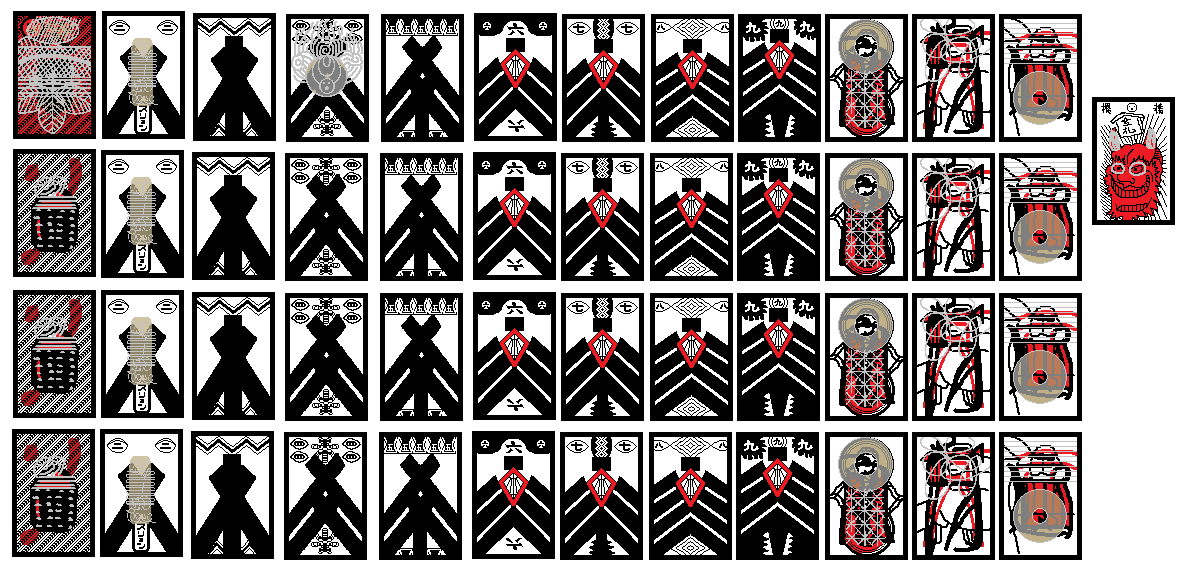
Because of the decreasing importance of suits in specific Japanese games played using Tensho Karuta and Mekurifuda, One-suited karuta decks were subsequently developed. This innovation helped players avoid confusing the cards due to the huge variation of illustrations in Mekurifuda decks.
There were two main classifications of these one-suited decks:
- Kabu Karuta, which use the suit of Clubs, and
- Mame Karuta, which use the suit of Coins.
Depending on the pattern, the deck may contain either 40 or 48 cards.
Just like the Mekurifuda, they were created to get around the ban on cards bearing Portuguese playing card designs, by transforming the usual courts and dragons into abstract shapes or strokes.
These cards in particular, were used for playing simpler Japanese card games, usually betting games. However, they were not exclusively used for such games only; Daini, for example, is attested to be used for playing Kujuroku, a fishing game.
For a list of games played using these cards, see Mekurifuda Games.
¶ Kabu Karuta
Kabu Karuta [かぶかるた] are card decks that consist of 4 copies of the suit of Clubs for every number in the deck.
The name may come from Kabufuda, which is the most popular pattern in this category, due to the other decks’ similarity in appearance with Kabufuda.
It may also refer to the fact that the decks were designed for playing Kabu [カブ] games, which were showdown or banking games that use the method of taking the ones digit of the sum of the numbers in a set of cards to determine it’s strength, with 0 being the lowest and 9 being the highest.
¶ Kinds of Kabu Karuta
| Pattern | Played in | Number of Cards | Description |
|---|---|---|---|
| Kabufuda | Kyoto, Osaka, Kobe, Tanba, Tango, Tajima, Banshu, Bizen, Kishu, Iga, Yamato, Kwachi, Izumi, Settsu | 40 | Consists of 4 copies of the numbers 1 to 10, with a special overprinted 1 and 4. The only court card “10” looks like a two-way Jack holding a very short sword, but its body is based on the Queen of Clubs of a western playing card deck (Some manufacturers used the King of Diamonds as a reference instead). Also called Nukinokichi because it is technically a reduced Irinokichi deck. |
| Irinokichi | Kishu, Shima, Ise (Japan) East & West Haozhou (China) |
48 | The original 48-card deck where Kabufuda came from. There are 3 court cards (10, 11, 12), whose designs look more like the 2 of coins, the horse of clubs, and the king of clubs in a mekurifuda deck. Comes with Onifuda. It is believed that the name comes from some manufacturers printing the character 吉 (kichi) in silver on one of the cards. Kingo-style games were often played using this pattern. |
| Kinseizan | Tsuruga, Kii, Ise, Shima | 48 | A deluxe version of Irinokichi where many of the cards are overprinted with silver and gold. All 1, 2, 10, 11, and 12 cards are overprinted. Special 4 is overprinted like Kabufuda, while Special 1 has a Paulownia and Cloud overprint. Comes with Onifuda. Variants of Hiki-Kabu, as well as Kingo-style games were played using this pattern. |
| Hosonokichi | Wakayama, Mie, Fukui | 48 | A budget version of Irinokichi where the Clubs and Swords are made up of thin lines. Originally, instead of using stencils to color the cards, they were hand-painted using a thin brush, as a way to reduce material cost and production time. |
| Dai-ichiroku | Karafuto (now Sakhalin, Russia) | 48 | The cards are bigger than Mame-ichiroku. 8 copies of the numbers 1 to 6. Used in the betting game Karafuto Kabu. |
¶ Mame Karuta
Mame Karuta [まめカルタ] are card decks that consist of 4 copies of the suit of Coins for every number in the deck.
The name refers to the round shape of the pips on the cards,which resemble beans [まめ, mame].
¶ Kinds of Mame Karuta
| Pattern | Played in | Number of Cards | Description |
|---|---|---|---|
| Daini or Daiji | Chikuzen, Chikugo, Buzen, Bungo, Hizen, Higo, Hyuga, Osumi, Shimonoseki (Japan) Some areas in Korea |
40 | Consists of 4 copies of the numbers 1 to 10, with a special overprinted 1, 3, and 4. Also, the normal 3 and 4 are overprinted. Comes with a red Onifuda. May or may not come with a Jizofuda. Despite there being a special 3 card, it has not been attested to be treated as a special card in games. A mekuri-style game called Kujuroku is played using this pattern. |
| Komaru | Tanba, Tango, Tajima, Bizen, Bicchu, Bingo, Aki, Suo, Nagato, Awa, Awaji, Iyo, Sanuki, Hokkaido | 40 | Structurally identical to Daini but the pips are smaller and the lines are thinner. Also the normal 4 are not overprinted. Comes with a red Onifuda. Kabu-style games such as Dare and Yoshi were know to have been played using this pattern. |
| Mefuda | Sanuki, Awa, Shikoku | 40 | Structurally similar to Daini but the pips look like black teardrops, the 10 are horses, and the 4, 7, 8, and 9 cards have what appears to be eyebrows or eyelashes. Special 1 and 2, 3, and 4 cards have “金銭不用” (money not used) printed on them. Comes with a red Onifuda. Jumai Kabu is known to have been played using this pattern. |
| Kudoyama or Kudosan | Hoki, Izumo, Inaba, Oki | 48 | Design-wise looks like an elaborately drawn Mekurifuda deck. Consists of 12 numbers; each number has 1 special overprinted card and 3 normal plain cards. The woodblock prints of 12 (King) and 10 (Maid) are switched. Comes with a red Onifuda. |
| Mame-ichiroku | Kinki, Chugoku, Wakayama, Fukui | 48 | The name may be a double entendre; the cards are small, and the pips look like beans. 8 copies of the numbers 1 to 6. Used by the banker in the betting game Tehonbiki. |
¶ Other One-suited Mekurifuda
| Pattern | Played in | Number of Cards | Description |
|---|---|---|---|
| Harifuda | Kinki, Chugoku, Shikoku | 48 | Consists of 8 copies of the numbers 1 to 6, written stylishly in kanji. There may also be markers on the top and bottom of the cards, allowing players to easily identify the number of the cards. Used by the players the betting game Tehonbiki. Traditionally they were painted in-house by the gambling parlor using blank “shirofuda” cards, but eventually ready-made Harifuda were sold by karuta manufacturers. |
| Shirofuda | - | 48 | A deck of 48 blank cards, meant to be painted original patterns by those who bought them. While technically not a one-suited karuta, they were practically used by underground gambling parlors for making Hari-fuda cards. |
¶ Gallery
¶ Kabu Karuta
| Pattern | The Deck |
|---|---|
| Kabufuda | 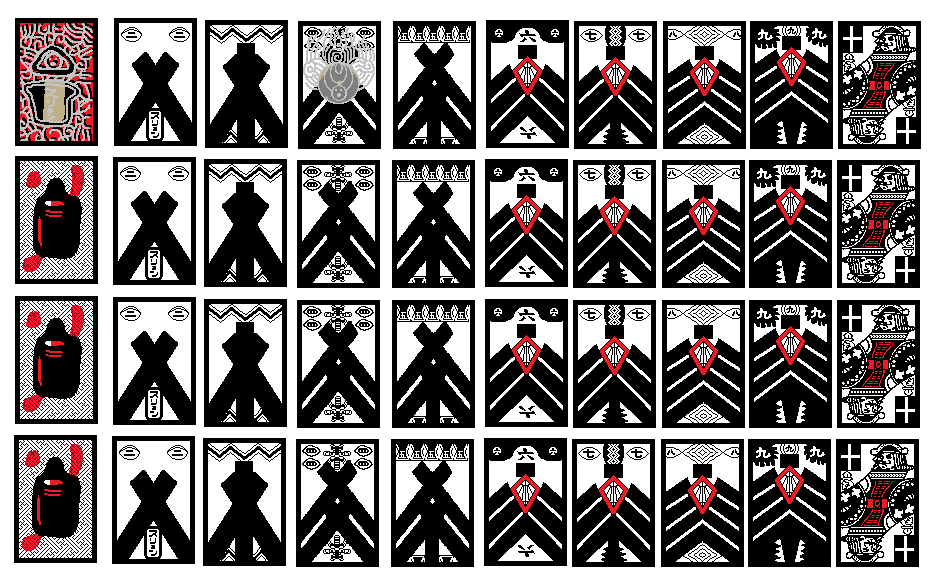 |
| Irinokichi | 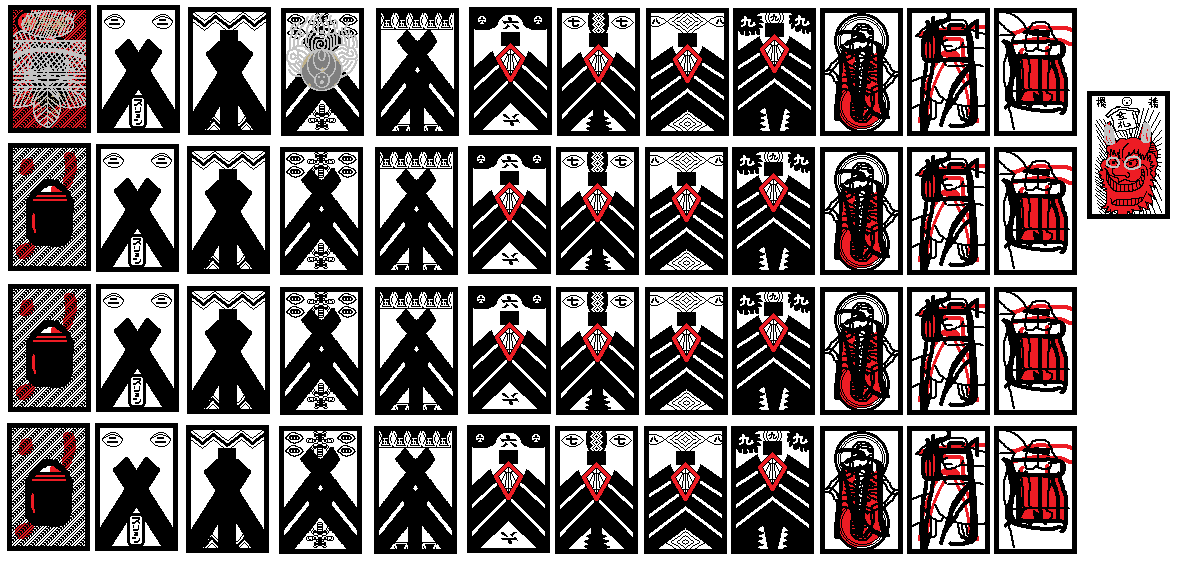 |
| Kinseizan |  |
| Hosonokichi | - |
| Dai-ichiroku |         |
¶ Mame Karuta
| Pattern | The Deck |
|---|---|
| Daini or Daiji | 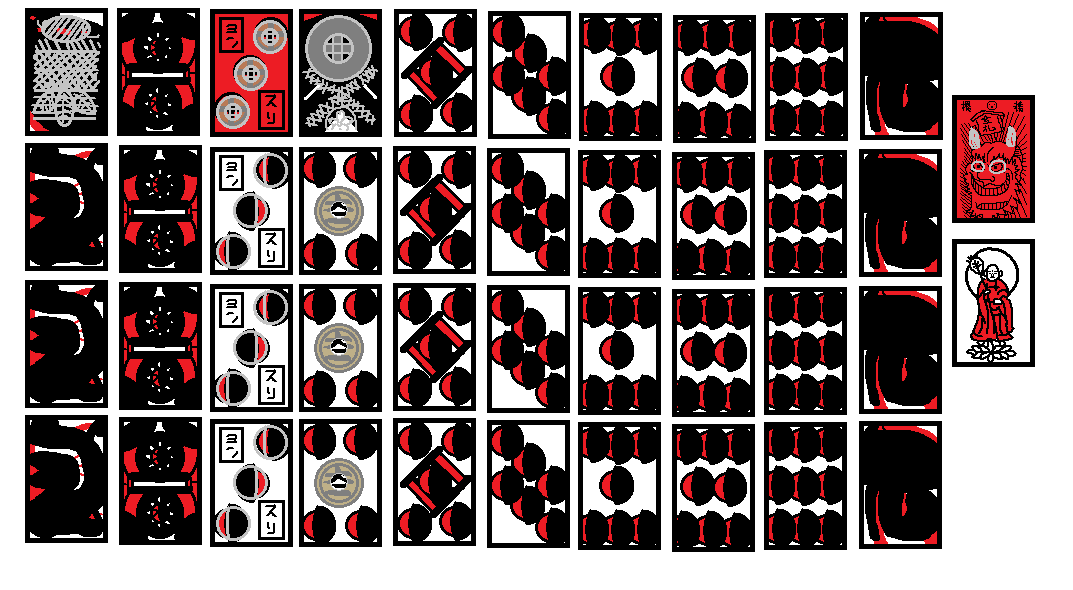 |
| Komaru | 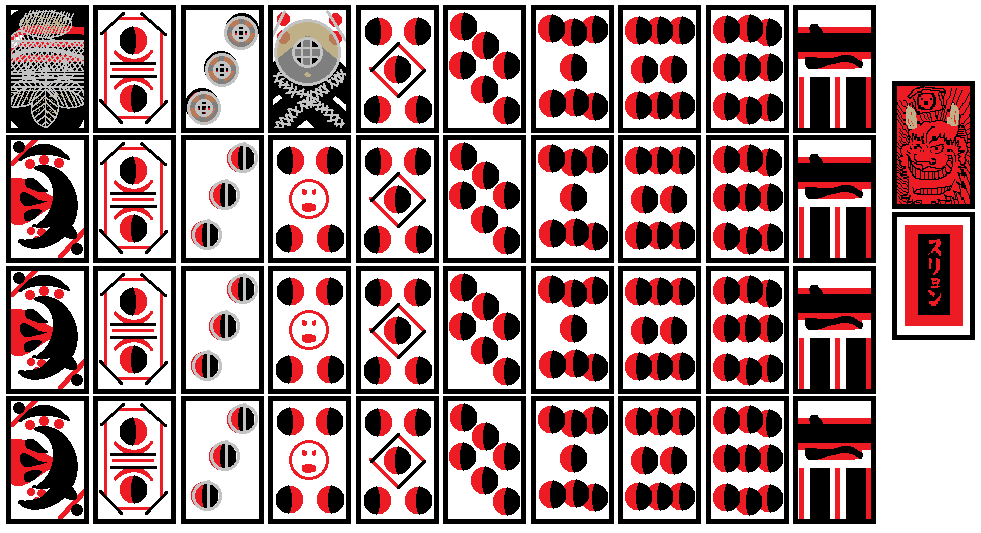 |
| Mefuda | 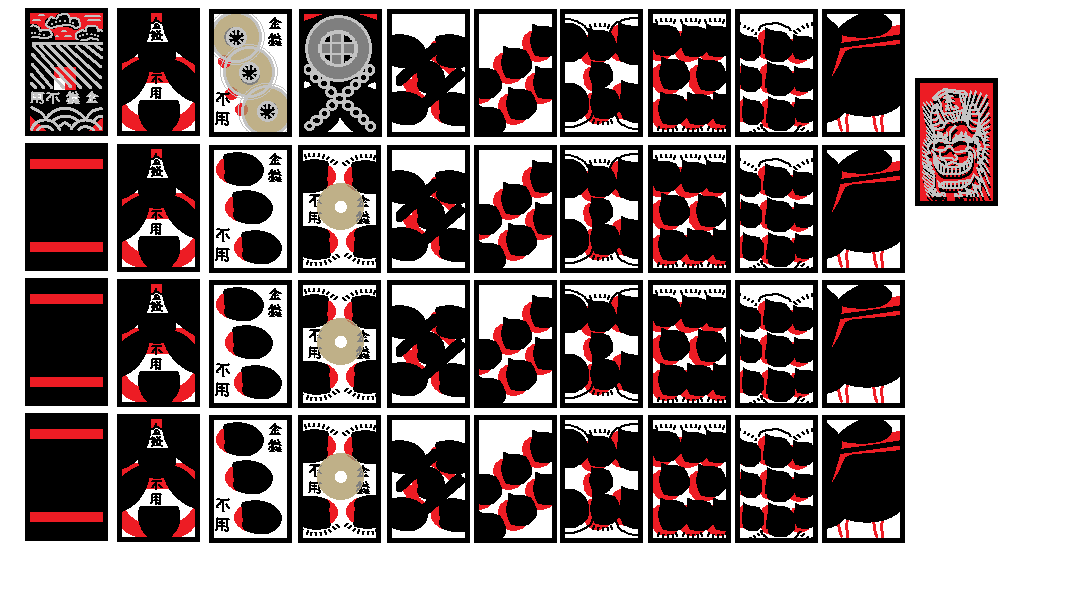 |
| Kudoyama or Kudosan | 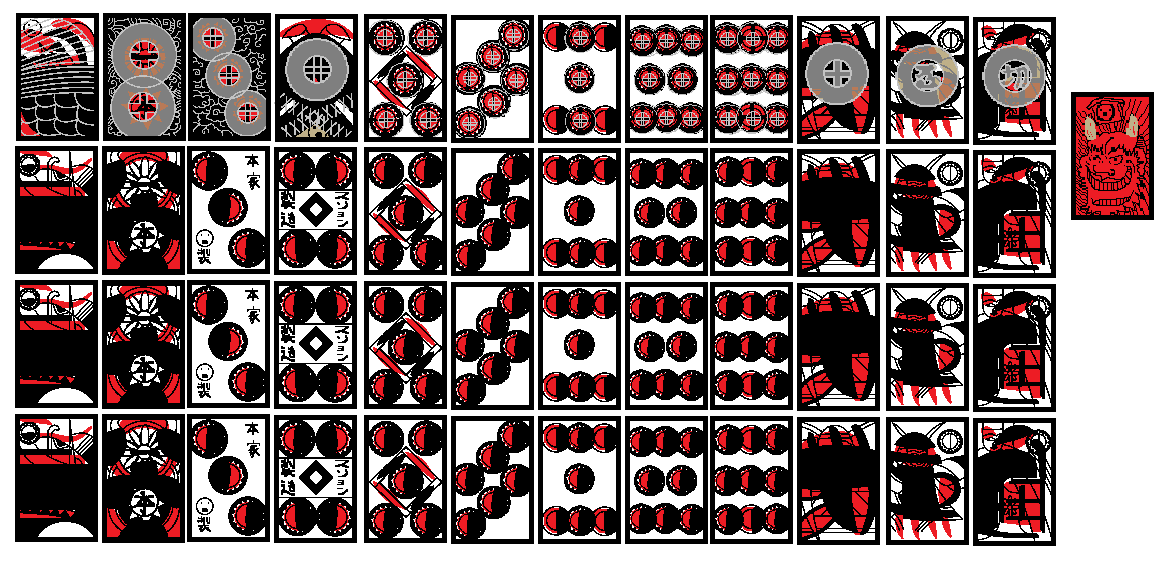 |
| Mame-ichiroku |         |
¶ Other One-Suited Mekurifuda
| Pattern | The Deck |
|---|---|
| Harifuda |         |
¶ Bibliography
- Nintendo Brands and Chiho-fuda poster, Late Taisho to Early Showa era.
- Nihon Karuta Chiho-fuda poster, Late Taisho to Early Showa era.
- https://japanplayingcardmuseum.com/kabu-karuta/
- https://japanplayingcardmuseum.com/mame-karuta/
- https://ja.wikipedia.org/wiki/天正かるた